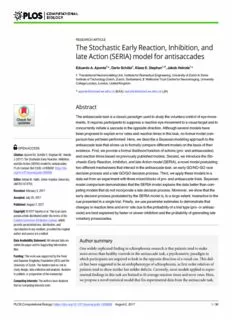
(SERIA) model for antisaccades PDF
Preview (SERIA) model for antisaccades
RESEARCHARTICLE The Stochastic Early Reaction, Inhibition, and late Action (SERIA) model for antisaccades EduardoA.Aponte1*,DarioScho¨bi1,KlaasE.Stephan1,2,JakobHeinzle1* 1 TranslationalNeuromodelingUnit,InstituteforBiomedicalEngineering,UniversityofZurich&Swiss InstituteofTechnologyZurich,Zurich,Switzerland,2 WellcomeTrustCentreforNeuroimaging,University CollegeLondon,London,UnitedKingdom *[email protected](EAA);[email protected](JH) a1111111111 Abstract a1111111111 a1111111111 Theantisaccadetaskisaclassicparadigmusedtostudythevoluntarycontrolofeyemove- a1111111111 ments.Itrequiresparticipantstosuppressareactiveeyemovementtoavisualtargetandto a1111111111 concurrentlyinitiateasaccadeintheoppositedirection.Althoughseveralmodelshave beenproposedtoexplainerrorratesandreactiontimesinthistask,noformalmodelcom- parisonhasyetbeenperformed.Here,wedescribeaBayesianmodelingapproachtothe antisaccadetaskthatallowsustoformallycomparedifferentmodelsonthebasisoftheir OPENACCESS evidence.First,weprovideaformallikelihoodfunctionofactions(pro-andantisaccades) Citation:AponteEA,Scho¨biD,StephanKE,Heinzle andreactiontimesbasedonpreviouslypublishedmodels.Second,weintroducetheSto- J(2017)TheStochasticEarlyReaction,Inhibition, chasticEarlyReaction,Inhibition,andlateActionmodel(SERIA),anovelmodelpostulating andlateAction(SERIA)modelforantisaccades. PLoSComputBiol13(8):e1005692.https://doi. twodifferentmechanismsthatinteractintheantisaccadetask:anearlyGO/NO-GOrace org/10.1371/journal.pcbi.1005692 decisionprocessandalateGO/GOdecisionprocess.Third,weapplythesemodelstoa Editor:AdrianM.Haith,JohnsHopkinsUniversity, datasetfromanexperimentwiththreemixedblocksofpro-andantisaccadetrials.Bayesian UNITEDSTATES modelcomparisondemonstratesthattheSERIAmodelexplainsthedatabetterthancom- Received:February5,2017 petingmodelsthatdonotincorporatealatedecisionprocess.Moreover,weshowthatthe earlydecisionprocesspostulatedbytheSERIAmodelis,toalargeextent,insensitivetothe Accepted:July20,2017 cuepresentedinasingletrial.Finally,weuseparameterestimatestodemonstratethat Published:August2,2017 changesinreactiontimeanderrorrateduetotheprobabilityofatrialtype(pro-orantisac- Copyright:©2017Aponteetal.Thisisanopen cade)arebestexplainedbyfasterorslowerinhibitionandtheprobabilityofgeneratinglate accessarticledistributedunderthetermsofthe voluntaryprosaccades. CreativeCommonsAttributionLicense,which permitsunrestricteduse,distribution,and reproductioninanymedium,providedtheoriginal authorandsourcearecredited. DataAvailabilityStatement:Allrelevantdataare Authorsummary withinthepaperanditsSupportingInformation Onewidelyreplicatedfindinginschizophreniaresearchisthatpatientstendtomake files. moreerrorsthanhealthycontrolsintheantisaccadetask,apsychometricparadigmin Funding:ThisworkwassupportedbytheRene´ whichparticipantsarerequiredtolookintheoppositedirectionofavisualcue.Thisdefi- andSusanneBraginskyFoundation(KES)andthe cithasbeensuggestedtobeanendophenotypeofschizophrenia,asfirstorderrelativesof UniversityofZurich.Thefundershadnorolein studydesign,datacollectionandanalysis,decision patientstendtoshowsimilarbutmilderdeficits.Currently,mostmodelsappliedtoexper- topublish,orpreparationofthemanuscript. imentalfindingsinthistaskarelimitedtofitaveragereactiontimesanderrorrates.Here, weproposeanovelstatisticalmodelthatfitsexperimentaldatafromtheantisaccadetask, Competinginterests:Theauthorshavedeclared thatnocompetinginterestsexist. PLOSComputationalBiology|https://doi.org/10.1371/journal.pcbi.1005692 August2,2017 1/36 SERIA—Amodelforerrorsandreactiontimesintheantisaccadetask beyondsummarystatistics.Themodelisinspiredbythehypothesisthatantisaccadesare theresultofseveralcompetingdecisionprocessesthatinteractnonlinearlywitheach other.Inapplyingthismodeltoarelativelylargeexperimentaldataset,weshowthat meanreactiontimesanderrorratesdonotfullyreflectthecomplexityoftheprocesses thatarelikelytounderlieexperimentalfindings.Inthefuture,ourmodelcouldhelpto understandthenatureofthedeficitsobservedinschizophreniabyprovidingastatistical tooltostudytheirbiologicalunderpinnings. Introduction Intheantisaccadetask([1];forreviews,see[2,3]),participantsarerequiredtosaccadeinthe contralateraldirectionofavisualcue.Thisbehavioristhoughttorequireboththeinhibition ofareflexivesaccadicresponsetowardsthecueandtheinitiationofavoluntaryeyemovement intheoppositedirection.Afailuretoinhibitthereflexiveresponseleadstoanerroneoussac- cadetowardsthecue(i.e.,aprosaccade),whichisoftenfollowedbyacorrectiveeyemovement intheoppositedirection(i.e.,anantisaccade).Asaprobeofinhibitorycapacity,theantisac- cadetaskhasbeenwidelyusedtostudypsychiatricandneurologicaldiseases[3].Notably, sincetheinitialreport[4],studieshaveconsistentlyfoundanincreasednumberoferrorsin patientswithschizophreniawhencomparedtohealthycontrols,independentofmedication andclinicalstatus[5–8].Moreover,thereisevidencethatanincreasederrorrateconstitutes anendophenotypeofschizophrenia,asantisaccadedeficitsarealsopresentinnon-affected, first-degreerelativesofdiagnosedindividuals(forexample[5,7];butfornegativefindingssee forexample[9,10]). Unfortunately,theexactnatureoftheantisaccadedeficitsandtheirbiologicaloriginin schizophreniaremainunclear.Onepathtoimproveourunderstandingoftheseexperimental findingsistodevelopgenerativemodelsoftheirputativecomputationaland/orneurophysio- logicalcauses[11].Generativemodelsthatcapturetheentiredistributionofresponsescan revealfeaturesofthedatathatarenotapparentwhenonlyconsideringsummarystatistics suchasmeanerrorrate(ER)andreactiontime(RT)[12–15].Additionally,thistypeofmodel canpotentiallyrelatebehavioralfindingsinhumanstotheirbiologicalsubstrate. Here,weapplyagenerativemodelingapproachtotheantisaccadetask.First,weintro- duceanovelmodelofthisparadigmbasedonpreviousproposals[16–20].Forthis,wefor- malizetheideasintroducedbyNooraniandCarpenter[17]andextendthemintowhatwe refertoastheStochasticEarlyReaction,Inhibition andlateAction(SERIA)model.Second, weapplybothmodelstoanexperimentaldatasetofthreemixedblocksofpro-andantisac- cadestrialswithdifferenttrialtypeprobability.Morespecifically,wecompareseveralmod- elsusingBayesianmodelcomparison.Third,weusetheparameterestimatesfromthebest modeltoinvestigatetheeffectsofourexperimentalmanipulation.Wefoundthattherewas positiveevidenceinfavoroftheSERIAmodelwhencomparedtoourformalizationofthe modelproposedin[17].Moreover,theparametersestimatedthroughmodelinversion revealedthecomplexityofthedecisionprocessesunderlyingtheantisaccadetaskthatisnot obviousfrommeanRTandER. Thispaperisorganizedasfollows.First,weformalizethemodeldevelopedin[17]andin- troducetheSERIAmodel.Second,wedescribeourexperimentalsetup.Third,wepresentour behavioralfindingsintermsofsummarystatistics(meanRTandER),thecomparisonbetween differentmodels,andtheparameterestimates.Finally,wereviewourfindings,discussother recentmodels,potentialfuturedevelopments,andtranslationalapplications. PLOSComputationalBiology|https://doi.org/10.1371/journal.pcbi.1005692 August2,2017 2/36 SERIA—Amodelforerrorsandreactiontimesintheantisaccadetask Materialsandmethods Ethicsstatement Allparticipantsgavewritteninformedconsentbeforethestudy.Allexperimentalprocedures wereapprovedbythelocalethicsboard(KantonaleEthikkomissionZu¨rich, KEK-ZH-Nr.2014-0246). Racemodelsforantisaccades Inthissection,wederiveaformaldescriptionofthemodelsevaluatedinthispaper.Westart withaformalizedversionofthemodelproposedbyNooraniandCarpenterin[17]andpro- ceedtoextendit.TheirapproachresemblesthemodeloriginallyproposedbyCamalierand colleagues[21]toexplainRTandERinthedoublestepandsearchsteptasks,inwhichpartici- pantsareeitheraskedtosaccadetosuccessivelypresentedtargetsortosaccadetoatargetafter adistractorwasshown.Commontoallthesetasksisthatsubjectsarerequiredtoinhibitapre- potentreactiontoaninitialstimulusandthentogenerateanactiontowardsasecondarygoal. Briefly,Camalierandcolleagues[21]extendedtheoriginal‘horse-race’model[16]byinclud- ingasecondaryactionincountermandingtasks.In[17],NooraniandCarpenterusedasimi- larmodelincombinationwiththeLATERmodel[22]inthecontextoftheantisaccadetaskby postulatinganendogenouslygeneratedinhibitorysignal.Notethatthismodel,orvariantsof it,havebeenusedinseveralexperimentalparadigms(reviewedin[20]).Here,welimitourdis- cussiontotheantisaccadetask. Thepro,stop,andantisaccademodel(PROSA) Following[17],weassumethattheRTandthetypeofsaccadegeneratedinagiventrialare causedbytheinteractionofthreecompetingprocessesorunits.Thefirstunitu representsa p commandtoperformaprosaccade,thesecondunitu representsaninhibitorycommandto s stopaprosaccade,andthethirdunitu representsacommandtoperformanantisaccade.The a timetrequiredforunitu toarriveatthresholds isgivenby: i i s ¼rt; ð1Þ i i s i ¼t; ð2Þ r i wherer representstheslopeorincreaserateofunitu,s representstheheightofthethreshold, i i i andtrepresentstime.Weassumethat,oneachtrial,theincreaseratesarestochasticandinde- pendentofeachother. Thetimeandorderinwhichtheunitsreachtheirthresholdss determinestheactionand i RTinatrial.Iftheprosaccadeunitu reachesthresholdbeforeanyotherunitattimet,apro- p saccadeiselicitedatt.Iftheantisaccadeunitarrivesfirst,anantisaccadeiselicitedatt.Finally, ifthestopunitarrivesbeforetheprosaccadeunit,anantisaccadeiselicitedatthetimewhen theantisaccadeunitreachesthreshold.Itisworthmentioningthat,althoughthismodelis motivatedasarace-to-thresholdmodel,actionsandRTsdependonlyonthearrivaltimesof eachoftheunitsandultimatelynoexplicitmodelofincreaseratesorthresholdsisrequired. Thus,forthesakeofclarity,werefertothisapproachasa‘race’model,incontrastto‘race-to- threshold’modelsthatexplicitlydescribeincreaseratesandthresholds. Formally(butinaslightabuseoflanguage),thetworandomvariablesofinterest,thereac- tiontimeT2[0,1[andthetypeofactionperformedA2{pro,anti},dependonlyonthreefur- therrandomvariables:thearrivaltimesU ,U,U 2[0,1[ofeachoftheunits.The p s a PLOSComputationalBiology|https://doi.org/10.1371/journal.pcbi.1005692 August2,2017 3/36 SERIA—Amodelforerrorsandreactiontimesintheantisaccadetask probabilityofperformingaprosaccadeattimetisgivenbytheprobabilityoftheprosaccade unitarrivingattimet,andthestopandantisaccadeunitarrivingafterwards: pðA¼pro;T ¼tÞ¼pðU ¼tÞpðU >tÞpðU >tÞ: ð3Þ p a s Theprobabilityofperforminganantisaccadeattimetisgivenby Z t pðA¼anti;T ¼tÞ¼pðU ¼tÞpðU >tÞpðU >tÞþpðU ¼tÞ pðU ¼tÞpðU >tÞdt: ð4Þ a p s a s p 0 ThefirsttermontherightsideofEq4correspondstotheunlikelycasethattheantisaccadeunit arrivesbeforetheprosaccadeandthestopunits.Thesecondtermdescribestrialsinwhichthestop unitarrivesbeforetheprosaccadeunit.Itcanbedecomposedintotwoterms: Z (cid:18) Z (cid:19) t t pðU ¼tÞ pðU ¼tÞpðU >tÞdt¼pðU ¼tÞ pðU <tÞpðU >tÞþ pðU ¼tÞpðt<U <tÞdt ð5Þ a s p a s p s p 0 0 (cid:18) Z (cid:19) t ¼pðU ¼tÞ pðU <tÞpðU >tÞþ pðU <tÞpðU ¼tÞdt ð6Þ a s p s p 0 R ThetermpðU ¼tÞ tpðU <tÞpðU ¼tÞdtdescribestheconditioninwhichtheprosaccade a 0 s p unitisinhibitedbythestopunitallowingforanantisaccade.Notethatiftheprosaccadeunit arriveslaterthantheantisaccadeunit,thearrivaltimeofthestopunitisirrelevant.That meansthatwecansimplifyEq4to (cid:18) Z (cid:19) t pðA¼anti;T ¼tÞ¼pðU ¼tÞ pðU >tÞþ pðU <tÞpðU ¼tÞdt : ð7Þ a p s p 0 Eqs3and7constitutethelikelihoodfunctionofasingletrial,anddefinethejointproba- bilityofanactionandthecorrespondingRT.WerefertothislikelihoodfunctionasthePRO- Stop-Antisaccade(PROSA)model.Itsharesthecentralassumptionsof[17],namely:(i)the timetoreachthresholdofeachoftheunitsisassumedtodependlinearlyontherater,(ii)it includesastopunitwhosefunctionistoinhibitprosaccadesand(iii)thereisnolateralinhibi- tionbetweenthedifferentunits.Finally,(iv)RTsareassumedtobeequaltothearrive-at- thresholdtimes.NotethattheRTdistributionsaredifferentfromthearrivaltimedistributions becauseoftheinteractionsbetweentheunitsdescribedabove.Themaindifferenceofthis modelcomparedto[17]isthatwedonotexcludeapriorithepossibilityoftheantisaccade unitarrivingearlierthantheotherunits.Asidefromthis,bothmodelsareconceptually equivalent. TheStochasticEarlyReaction,Inhibition,andLateActionModel (SERIA) ThePROSAmodelischaracterizedbyastrictassociationbetweenunitsandactiontypes.In otherwords,theunitu leadsunequivocallytoaprosaccade,whereastheunitu alwaystrig- p a gersanantisaccade.Thisimpliesthatifthedistributionofthearrivaltimesoftheunitsisuni- modalandstrictlypositive,thePROSAmodelcannotpredictvoluntaryslowprosaccadeswith alatepeak,orinsimplewords,thePROSAmodelcannotaccountforslow,voluntaryprosac- cadesthathavebeenpostulatedintheantisaccadetask[23].Similarly,ithasbeenarguedthat prosaccadeRTcanbedescribedbythemixtureoftwodistributions(forexample[2,22]). Toaccountforthis,weintroducetheStochasticEarlyReaction,InhibitionandLateAction (SERIA)model. PLOSComputationalBiology|https://doi.org/10.1371/journal.pcbi.1005692 August2,2017 4/36 SERIA—Amodelforerrorsandreactiontimesintheantisaccadetask Fig1.LayoutoftheSERIAmodel.Thepresentationofavisualcue(agreenbar)triggerstheraceofthreeindependent units.Theinhibitoryunitcanstopanearlyresponse.Importantly,bothearlyandlateresponsescantriggerpro-and antisaccades.NotethatthePROSAmodelisaspecialcaseoftheSERIAmodelinwhichπ =1andπ=0,i.e.allearly e l responsesareprosaccades,whereasalllateresponsesareantisaccades. https://doi.org/10.1371/journal.pcbi.1005692.g001 Accordingtothismodel,andinanalogytothePROSAmodel,anearlyreactiontakesplace attimetiftheearlyunitu arrivesbeforethelateandinhibitoryunits,u andu,respectively.If e l i theinhibitoryorlateunitarrivesbeforetheearlyunit,alateresponseistriggeredatthetime thelateunitreachesthreshold.Crucially,bothearlyandlateresponsescantriggerpro-and antisaccadeswithacertainprobability.Thus,inparalleltotheraceprocesseswhichdetermine RTs,anindependent,secondarydecisionprocessisresponsibleforwhichreactionisgener- ated.Fig1showsthestructureoftheSERIAmodel. Toformalizetheconceptofearlyandlateresponses,weintroduceanewunobservableran- domvariablethatrepresentsthetypeofresponseR2{early,late}.ThedistributionoftheRTs isanalogoustothePROSA-model,suchthat,forinstance,theprobabilityofanearlyresponse attimetisgivenby pðR¼early;T ¼tÞ¼pðU ¼tÞpðU >tÞpðU >tÞ ð8Þ e i l whereU,U,andU representthearrivaltimesoftheearly,inhibitory,andlateunits,respec- e i l tively.ThefundamentalassumptionoftheSERIAmodelisthatasecondarydecisionprocess, beyondtheracebetweenearly,inhibitory,andlateunits,decidestheactiongeneratedinasin- gletrial.Aninitialapproachtomodelthissecondarydecisionprocessistoassumethatthe actiontype(pro-orantisaccade)isconditionallyindependentoftheRTgiventheresponse PLOSComputationalBiology|https://doi.org/10.1371/journal.pcbi.1005692 August2,2017 5/36 SERIA—Amodelforerrorsandreactiontimesintheantisaccadetask type(earlyorlate).Hence,thedistributionofRTsisnotaprioricoupledtothesaccadetype anymore;RTdistributionsforbothpro-andantisaccadescouldinprinciplebebimodal,con- sistingofbothfastreactiveandslowvoluntarysaccades. Formally,theconditionalindependencyassumptioncanbewrittendownas pðA;TjRÞ¼pðAjRÞpðTjRÞ; ð9Þ pðA;TjRÞpðRÞ¼pðAjRÞpðTjRÞpðRÞ; ð10Þ pðA;T;RÞ¼pðAjRÞpðT;RÞ: ð11Þ Thetermp(A|R)issimplytheprobabilityofanaction,givenaresponsetype.Wedenoteitas pðA¼projR¼earlyÞ¼p 2½0;1(cid:138); ð12Þ e pðA¼antijR¼earlyÞ¼1(cid:0) p; ð13Þ e pðA¼projR¼lateÞ¼p 2½0;1(cid:138); ð14Þ l pðA¼antijR¼lateÞ¼1(cid:0) p: ð15Þ l SincethetypeofresponseRisnotobservable,itisnecessarytomarginalizeitoutinEq11to obtainthelikelihoodoftheSERIAmodel: pðA;TÞ¼pðA;T;R¼earlyÞþpðA;T;R¼lateÞ: ð16Þ ThecompletelikelihoodofthemodelisgivenbysubstitutingthetermsinEq16 pðA¼pro;T ¼tÞ¼ppðU ¼tÞpðU >tÞpðU >tÞþ e e i l (cid:18) Z (cid:19) t ppðU ¼tÞ pðU >tÞþ pðU ¼tÞpðU <tÞdt ; ð17Þ l l e e i 0 pðA¼anti;T ¼tÞ¼ð1(cid:0) pÞpðU ¼tÞpðU >tÞpðU >tÞþ e e i l (cid:18) Z (cid:19) t ð1(cid:0) pÞpðU ¼tÞ pðU >tÞþ ðU ¼tÞpðU <tÞdt : ð18Þ l l e e i 0 ItisworthnotingherethatthePROSAmodelisaspecialcaseoftheSERIAmodel,namely,it correspondstotheassumptionthatπ =1andπ =0.TheSERIAmodelallowsforbimodaldistri- e l butions,asbothearlyandlateresponsescanbepro-andantisaccades.Importantly,onepredic- tionofthemodelisthatlateprosaccadeshavethesamedistributionaslateantisaccades. Alateracecompetitionmodelforsaccadetype Untilnow,wehaveassumedthatthecompetitionthatleadstolatepro-andantisaccadesdoes notdependontimeinthesensethatlateactionsareconditionallyindependentofRT.This assumptioncanbeweakenedbypostulatingasecondaryracebetweenlateresponses;this leadsustoamodifiedversionoftheSERIAmodel,thatwerefertoasthelateraceSERIA model(SERIA ).ThederivationproceedssimilarlytotheSERIAmodel,exceptthatwepostu- lr lateafourthunitthatgenerateslateprosaccadesinsteadofassumingthatthelatedecisionpro- cessistimeinsensitive. PLOSComputationalBiology|https://doi.org/10.1371/journal.pcbi.1005692 August2,2017 6/36 SERIA—Amodelforerrorsandreactiontimesintheantisaccadetask ThisversionoftheSERIAmodelincludesanearlyunitu that,forsimplicity,weassume e producesonlyprosaccades,aninhibitoryunitthatstopsearlyresponsesu,alateunitthattrig- i gersantisaccadesu ,andafurtherunitthattriggerslateprosaccadesu .Asbefore,iftheearly a p unitreachesthresholdbeforeanyotherunit,aprosaccadeisgeneratedwithprobability pðU ¼tÞpðU >tÞpðU >tÞpðU >tÞ: ð19Þ e i a p Ifanyofthelateunitsarrivefirst,therespectiveactionisgeneratedwithprobability: Antisaccade: pðU ¼tÞpðU >tÞpðU >tÞpðU >tÞ: ð20Þ a p e i Prosaccade: pðU ¼tÞpðU >tÞpðU >tÞpðU >tÞ: ð21Þ p a e i Finally,iftheinhibitoryunitarrivesfirst,eitheralatepro-orantisaccadeisgeneratedwith probability 0 1 Zt B C Antisaccades: pðU ¼tÞpðU >tÞ@ pðU ¼tÞpðU >tÞdtA; ð22Þ a p i e 0 0 1 Zt B C Prosaccades: pðU ¼tÞpðU >tÞ@ pðU ¼tÞpðU >tÞdtA: ð23Þ p a i e 0 Implicitinthelasttwotermsisthecompetitionbetweenthelateunits,whichareassumed againtobeindependentofeachother.Formally,thiscompetitionisexpressedastheprobabil- ityof,forexample,thelateantisaccadeunitarrivingbeforealateprosaccadep(U =t)p(U > a p t).AschematicrepresentationofthemodelisshowninFig2.Thislateraceissimilartothe LinearBallisticAccumulationmodelproposedby[24],althoughinthatmodeldecisionsare seenastheresultofaraceofballisticaccumulationprocesseswithfixedthresholdbutstochas- ticbaselineandincreaserate.HereweonlyassumethatthelatedecisionprocessisaGO-GO race[21]. Thelikelihoodofanactionisgivenbysummingoverallpossibleoutcomesthatleadtothat action: pðA¼pro;T ¼tÞ¼pðU ¼tÞpðU >tÞpðU >tÞpðU >tÞþ e i a p 0 1 Zt B C pðU ¼tÞpðU >tÞpðU >tÞpðU >tÞþpðU ¼tÞpðU >tÞ@ pðU ¼tÞpðU >tÞdtA;ð24Þ p a i e p a i e 0 pðA¼anti;T ¼tÞ¼pðU ¼tÞpðU >tÞpðU >tÞpðU >tÞþ a p i e 0 1 Zt B C pðU ¼tÞpðU >tÞ@ pðU ¼tÞpðU >tÞdtA: ð25Þ a p i e 0 WehaveleftoutsomepossiblesimplificationsinEqs24and25forthesakeofclarity. PLOSComputationalBiology|https://doi.org/10.1371/journal.pcbi.1005692 August2,2017 7/36 SERIA—Amodelforerrorsandreactiontimesintheantisaccadetask Fig2.LayoutoftheSERIA model.Thepresentationofavisualcue(agreenbar)triggerstheraceoffour lr independentunits.Theinhibitoryunitcanstopanearlyresponse.Thelatedecisionprocessistriggeredbythe competitionbetweentwofurtherunits. https://doi.org/10.1371/journal.pcbi.1005692.g002 Theconditionalprobabilityofalateantisaccadeisgivenbytheinteractionbetweenthelate units,suchthat Z1 pðU <U Þ¼ pðU ¼tÞpðU >tÞdt ¼1(cid:0) pðU <U Þ; ð26Þ a p a p p a 0 isanalogoustotheprobabilityofalateantisaccade1−π intheSERIAmodel.Thisobservation l showsthatthemaindifferencebetweentheSERIAandSERIA modelisthattheformerpos- lr tulatesthatthedistributionoflatepro-andantisaccadesareequalandconditionallyindepen- dentoftheactionperformed,whereasthelatterconstrainstheprobabilityofalateantisaccade tobeafunctionofthearrivaltimesofthelateunits. Theexpectedresponsetimeoflatepro-andantisaccadeactionsisgivenby Z1 1 tpðU ¼tÞpðU >tÞdt; ð27Þ pðU <U Þ p a p a 0 PLOSComputationalBiology|https://doi.org/10.1371/journal.pcbi.1005692 August2,2017 8/36 SERIA—Amodelforerrorsandreactiontimesintheantisaccadetask Z1 1 tpðU ¼tÞpðU >tÞdt: ð28Þ pðU <U Þ a p a p 0 Wewillrefertothesetermsasthemeanresponsetimeofpro-andantisaccadeactions,incon- trasttothemeanarrivaltimes,whicharetheexpectedvalueofanysingleunit. Non-decisiontime Themodelsabovecanbefurtherfinessedtoaccountfornon-decisiontimesδbytransforming theRTttot =t−δ.Thedelayδmightbecausedby,forexample,conductancedelaysfromthe δ retinatothecortex.Inaddition,theantisaccadeorlateunitsmightincludeaconstantdelayδ , a whichisoftenreferredtoastheantisaccadecost[1].Notethatthemodelishighlysensitiveto δbecauseanyRTbelowithaszeroprobability.Inordertorelaxthisconditionandtoaccount forearlyoutliers,weassumedthatsaccadescouldbegeneratedbeforeδatarateη2[0,1]such thatthemarginallikelihoodofanoutlieris pðT <dÞ¼pðT <0Þ¼Z: ð29Þ d Forsimplicity,weassumethatoutliersaregeneratedwithuniformprobabilityintheinterval [0,δ]: Z pðT ¼tÞ¼ if t <d: ð30Þ d Furthermore,weassumethattheprobabilityofanearlyoutlierbeingaprosaccadewas approximately100timeshigherthanbeinganantisaccade.Becauseofthenewparameterη, thedistributionofsaccadeswithaRTlargerthanδneedstoberenormalizedbythefactor 1−η.InthecaseofthePROSAmodel,forexample,thismeansthatthejointdistributionof actionandRTisgivenbytheconditionalprobability pðA¼pro;T ¼t jt >0Þ¼pðU ¼t ÞpðU >t (cid:0) d ÞpðU >t Þ; ð31Þ d d p d a d a s d pðU <0Þ¼0; ð32Þ a (cid:18) Z (cid:19) td pðA¼anti;T ¼t jt >0Þ¼pðU ¼t (cid:0) d Þ pðU >t Þþ pðU ¼tÞpðU <tÞdt : ð33Þ d d a d a p d p s 0 AsimilarexpressionholdsfortheSERIAmodels.However,inthePROSAmodelaunit- specificdelayisequaltoanaction-specificdelay.Bycontrast,intheSERIAmodelbothearly andlateresponsescangeneratepro-andantisaccades.Thus,δ representsadelayinthelate a actionsthataffectsbothlatepro-andantisaccades. Parametricdistributionsoftheincreaserate Themodelsdiscussedintheprevioussectionscanbedefinedindependentlyofthedistribution oftherateofeachoftheunits.Inordertofitexperimentaldata,weconsideredfourparametric distributionswithpositivesupportfortherates:gamma[13],inversegamma,lognormal[25] andthetruncatednormaldistribution(similarlyto[22]and[24]).Table1andFig3summa- rizethesedistributions,theirparameters,andthecorrespondingarrivaltimedensities.We consideredfivedifferentconfigurations:1)allunitswereassignedinversegammadistributed rates,2)allunitswereassignedgammadistributedrates,3)theincreaserateoftheprosaccade PLOSComputationalBiology|https://doi.org/10.1371/journal.pcbi.1005692 August2,2017 9/36 SERIA—Amodelforerrorsandreactiontimesintheantisaccadetask Table1. Parametricdensityfunctionsoftheincreaserates. Name Parameters Ratep.d.f. Arrivaltimep.d.f. Gamma k,θ y(cid:0)ke(cid:0)r=yrk(cid:0)1 yk e(cid:0)y=tt(cid:0)k(cid:0)1 GðkÞ GðkÞ Inv.gamma k,θ yk e(cid:0)y=rr(cid:0)k(cid:0)1 y(cid:0)ke(cid:0)t=ytk(cid:0)1 GðkÞ GðkÞ Lognormal μ,σ2 pffi1ffiffiffi e(cid:0)12ðlnrs(cid:0)mÞ2 pffi1ffiffiffi e(cid:0)12ðlntsþmÞ2 2psr 2pst (cid:0) (cid:1) T.normal μ,σ2 Z1e(cid:0)12ðr(cid:0)smÞ2 Z1t2e(cid:0)12 t(cid:0)1s(cid:0)m 2 R (cid:16) (cid:17) ZisthenormalizationconstantZ¼ 1exp (cid:0) ðr(cid:0)mÞ2 dr. 0 2s2 https://doi.org/10.1371/journal.pcbi.1005692.t001 andstopunits(orearlyandtheinhibitoryunits)wasgammadistributedbuttheantisaccade (late)unit’sincreaseratewasinversegammadistributed,4)alltheunitswereassignedlognor- maldistributedratesor5)allunitswereassignedtruncatednormaldistributedrates. Alltheparametricdistributionsconsideredherecanbefullycharacterizedbytwoparame- terswhichwegenericallyrefertoaskandθ.Hence,thePROSAmodelischaracterizedbythe parametersforeachunitk ,k ,k,θ ,θ ,θ.TheSERIAmodelcanbecharacterizedbyanalogous p a s p a s parametersk,k,k,θ,θ,θ andtheprobabilitiesofearlyandlateprosaccadesπ andπ.Inthe e l i e l i e l caseoftheSERIA model,theprobabilityofalateprosaccadeisreplacedbytheparametersof lr alateprosaccadeunitk ,θ .Inadditiontotheunitparameters,allmodelsincludedthenon- p p decisiontimeδ,theantisaccade(orlateunit)costδ ,andthemarginalrateofearlyoutliersη. a Experimentalprocedures Inthissection,wedescribetheexperimentalprocedures,statisticalmethods,andinference schemeusedtoinvertthemodelsabove.Thedataisfromtheplaceboconditionofalarger pharmacologicalstudythatwillbereportedelsewhere. Fig3.Illustrationofprobabilitydistributionsusedtomodelincreaserates.Left:Distributionoftheratesbasedondifferentprobabilitydensity functions:Normal(red),gamma(blue),inversegamma(green),andlog-normal(cyan).Alldistributionswerematchedtohaveequalmeanand variance.Center:Probitplotsofthesamedistributions.Whilethegammaandlognormaldistributionsareveryclosetothestraightlineinducedbythe normaldistribution,theinversegammadistributiondivergesslightlymorefromlinearity.Right:Arrivaltimedistribution(scaledtoms). https://doi.org/10.1371/journal.pcbi.1005692.g003 PLOSComputationalBiology|https://doi.org/10.1371/journal.pcbi.1005692 August2,2017 10/36
Description: